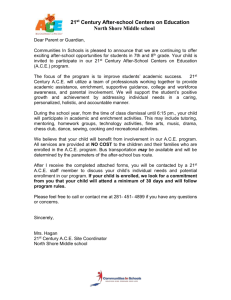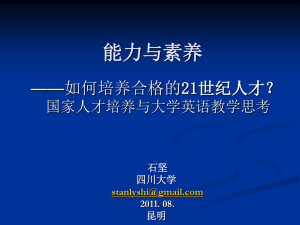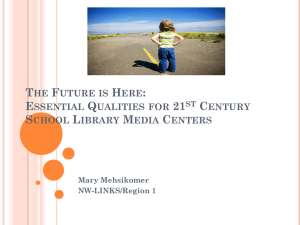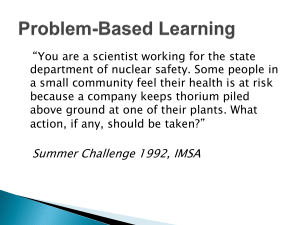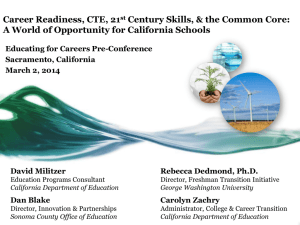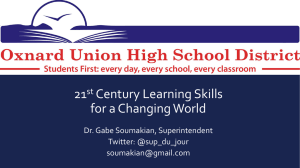21st Century Skills
advertisement
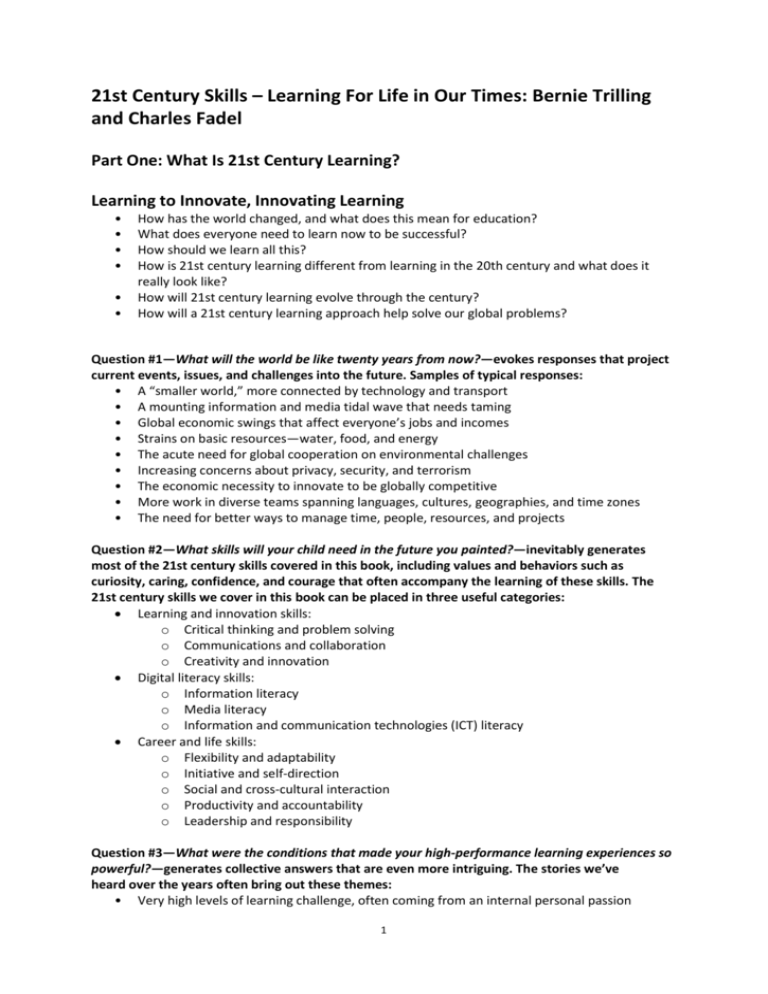
21st Century Skills – Learning For Life in Our Times: Bernie Trilling and Charles Fadel Part One: What Is 21st Century Learning? Learning to Innovate, Innovating Learning • • • • • • How has the world changed, and what does this mean for education? What does everyone need to learn now to be successful? How should we learn all this? How is 21st century learning different from learning in the 20th century and what does it really look like? How will 21st century learning evolve through the century? How will a 21st century learning approach help solve our global problems? Question #1—What will the world be like twenty years from now?—evokes responses that project current events, issues, and challenges into the future. Samples of typical responses: • A “smaller world,” more connected by technology and transport • A mounting information and media tidal wave that needs taming • Global economic swings that affect everyone’s jobs and incomes • Strains on basic resources—water, food, and energy • The acute need for global cooperation on environmental challenges • Increasing concerns about privacy, security, and terrorism • The economic necessity to innovate to be globally competitive • More work in diverse teams spanning languages, cultures, geographies, and time zones • The need for better ways to manage time, people, resources, and projects Question #2—What skills will your child need in the future you painted?—inevitably generates most of the 21st century skills covered in this book, including values and behaviors such as curiosity, caring, confidence, and courage that often accompany the learning of these skills. The 21st century skills we cover in this book can be placed in three useful categories: Learning and innovation skills: o Critical thinking and problem solving o Communications and collaboration o Creativity and innovation Digital literacy skills: o Information literacy o Media literacy o Information and communication technologies (ICT) literacy Career and life skills: o Flexibility and adaptability o Initiative and self-direction o Social and cross-cultural interaction o Productivity and accountability o Leadership and responsibility Question #3—What were the conditions that made your high-performance learning experiences so powerful?—generates collective answers that are even more intriguing. The stories we’ve heard over the years often bring out these themes: • Very high levels of learning challenge, often coming from an internal personal passion 1 • • Equally high levels of external caring and personal support—a demanding but loving teacher, a tough but caring coach, or an inspirational learning guide Full permission to fail—safely, and with encouragement to apply the hard lessons learned from failure to continuing the struggle with the challenge at hand This last point is extremely important. Failures, well supported, can often be better teachers than easy successes (though this is certainly not a very popular approach in today’s “test success”–driven schools). Question #4—What would school be like if it were designed around your answers to Questions #1 through #3?—consistently spotlights the distance between what we all know learning should be and what most schools end up doing each day: • The world of work is increasingly made of teams working together to solve problems and create something new—why do students mostly work alone and compete with others for teacher approval? • Technology is more a part of our children’s lives each day—why should they have to check their technology at the classroom door and compete for limited school computer time? • The world is full of engaging, real-world challenges, problems, and questions—why spend so much time on disconnected questions at the end of a textbook chapter? • Doing projects on something one cares about comes naturally to all learners—why are learning projects so scarce inside so many classrooms? • Innovation and creativity are so important to the future success of our economy—why do schools spend so little time on developing creativity and innovation skills? So why is education falling short in preparing students for 21st century work? The world of Knowledge Age work requires a new mix of skills. Jobs that require routine manual and thinking skills are giving way to jobs that involve higher levels of knowledge and applied skills like expert thinking and complex communicating. Four powerful forces are converging and leading us toward new ways of learning for life in the 21st century (21): • Knowledge work • Thinking tools • Digital lifestyles • Learning research These four forces are simultaneously creating the need for new forms of learning in the 21st century and supplying the tools. The Turning of Learning: Toward a New Balance The new slogan for the Singapore Education System: “Teach Less, Learn More.” (37) 2 A New Balance (38) 3 Part Two: What Are 21st Century Skills? Learning to Create Together The core subjects and interdisciplinary 21st century themes are surrounded by the three sets of skills most in demand in the 21st century: Learning and innovation skills Information, media, and technology skills Life and career skills Learning to Learn and Innovate The first set of 21st century skills focuses on critical learning skills and innovation (49): • Critical thinking and problem solving (expert thinking) • Communication and collaboration (complex communicating) • Creativity and innovation (applied imagination and invention) Critical Thinking and Problem Solving Critical thinking and problem solving are considered by many to be the new basics of 21st century learning. Communication and Collaboration While education has always been concerned with the basics of good communicating—correct speech, fluent reading, and clear writing—digital tools and the demands of our times call for a much wider and deeper personal portfolio of communication and collaboration skills to promote learning together. Creativity and Innovation Given the 21st century demands to continuously innovate new services, better processes, and improved products for the world’s global economy, and for the creative knowledge work required in more and more of the world’s better-paying jobs, it should come as no surprise that creativity and innovation are very high on the list of 21st century skills. In fact, many believe that our current Knowledge Age is quickly giving way to an Innovation Age, where the ability to solve problems in new ways (like the greening of energy use), to invent new technologies (like bio- and nanotechnology) or create the next killer application of existing technologies (like efficient and affordable electric cars and solar panels), or even to discover new branches of knowledge and invent entirely new industries, will all be highly prized. Digital Literacy Skills info-savvy, media-fluent, tech-tuned • • Information literacy Media literacy Information and communication technology (ICT) literacy Information Literacy In the 21st century, everyone’s level of information literacy and fluency will need to rise. Whether at work, in school, at home, or in the community, there will be increasing demands on our ability to: • Access information effi ciently and effectively • Evaluate information critically and competently 4 • Use information accurately and creatively Media Literacy Surrounded by digital media and media choices, 21st century students need to understand how to best apply the media resources available for learning, and to use media creation tools to create compelling and effective communication products such as videos, audio podcasts, and Web sites. ICT Literacy Information and communication technologies, or ICTs, are the quintessential tools of the 21st century. As discussed in Chapter Two, the net generation, today’s “digital natives,” are “bathed in bits” from birth, clutching remote controls, computer mice, and cell phones from an early age. But using these tools well for learning is another story. ...Though our tech-tuned 21st century students are often more fluent in the use of technology than their parents or teachers, they will always need guidance in how to best apply these powerful tools to complex learning and creative tasks. Career and Life Skills work-ready, prepared for life Flexibility and Adaptability We are in a time of great change. Flexibility and adaptability are now essential skills for learning, work, and citizenship in the 21st century. The rapid pace of technological change forces us all to adapt quickly to new ways of communicating, learning, working, and living. We switch jobs and careers more frequently, and entirely new kinds of work are arising from innovations in many fi elds. One of the few unchanging aspects of the 21st century knowledge economy is the universal need to organize work into well-defi ned projects carried out by global project teams on tight time schedules with limited resources. Initiative and Self-Direction In our always-on, fast-paced, flattened world of work, time for extended training and motivational development is in very short supply. Workers must arrive motivated, ready to use their initiative to get things done, and prepared to be highly self-reliant in everyday work. Social and Cross-Cultural Interaction Diverse work teams, scattered around the globe and connected by technology, are becoming the norm for 21st century work. Diverse schools and communities are also becoming more common worldwide. The ability to work effectively and creatively with team members and classmates regardless of differences in culture and style is an essential 21st century life skill. Understanding and accommodating cultural and social differences, and using these differences to come up with even more creative ideas and solutions to problems, will be increasingly important throughout our century. Recent research on the importance of emotional and social intelligence to a child’s development and to successful learning has led to a wide variety of programs and learning materials that support social skills and social responsibility. Productivity and Accountability Productive workers and learners have been in demand in both business and education down the centuries. Setting and meeting goals, prioritizing work, and using time well are all skills that support working and learning equally well. With an expanding toolkit of knowledge work tools designed to boost personal and group productivity, both efficiency and effectiveness in learning and work are increasing dramatically. Technology is also easing the burden of accountability—the tracking 5 and sharing of work done and lessons learned. Projects—defining, planning, executing, and evaluating them—have become the currency of 21st century work. Leadership and Responsibility People coming together to work on a project they care about, dividing the work up among the team, taking on roles that play to their strengths, everyone contributing to a creative outcome and celebrating the results, then each person moving on to the next project with a different set of players, has been called the “studio model”—for the ways that fi lms and television programs are produced in media production studios. This project-based, studio model of work is becoming more prevalent in the knowledge work economy, and will be an important work style to master in the 21st century. The studio model also offers students a powerful style of learning that can provide lots of opportunities to take responsibility and exercise leadership—skills important to future employers. (85) 6

